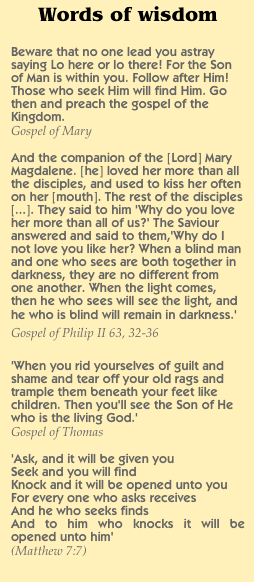 |
||
Mary Magdalene: our spiritual guide Mary Magdalene was Christ’s companion and closest disciple, according to the Gospel of Thomas – one of the lost gospels found at Nag Hammadi in 1946. It was one of many early Christian works excluded from the Bible by a cleric called Athanasius, a bigoted man who used torture and violence to enforce his rigid views on the rest of the early Church. In fact, Athanasius’s view that violence was justified to save people from Hell was used as the ‘inspiration’ for the infamous Inquisition set up by the Catholic Church in 1231, to persecute the Cathars in southern France. The many references to Mary Magdalene in Thomas and the other so-called ‘gnostic’ gospels found at Nag Hammadi show that she was one of Christ’s leading disciples.In the Pistis Sophia, her name is mentioned 150 times – compare that with just 13 times in Matthew, Mark, Luke and John combined.There are even fragments of a gospel in her name. In fact, the New Testament gospels were heavily altered to reflect the rigid, hierarchical view of the Catholic Church, and marginalise the role of women – who had played an active part in the early Christian church. If nothing else, this evidence should make us re-evaluate the role of women in the church, and remove any flimsy theological objections to women becoming priests or bishops, that have no basis either in the history of the early Christian church, or in scripture. But it goes far beyond that. It is tempting to believe that the New Testament is literally the word of God, but once you realise how much it has been tampered with, then you have to reconsider whether the exclusion of the gnostic gospels, by Athanasius and others, was really justified. Did Jesus really die on the cross to save our souls from eternal damnation? Or rather, did he come to teach that the way to the soul’s salvation is through personal revelation? Of the six early Christian churches, just one – Rome – believed in hell; the others believed in something called ‘universal salvation’. Christians just could not believe that a loving God would condemn anyone to an eternity of suffering. The gnostic belief was that we need to find the Christ within each of us, to receive and understand the ultimate spiritual truth. Luke says: “The kingdom of God cometh not with observation: Neither shall they say, ‘Lo here!’ or, ‘Lo there!’ for, behold, the kingdom of God is within you.” (Luke 17:20-21) And in Thomas we have: ‘The (Father’s) kingdom is within you and it is outside you. When you know yourselves, then you will be known, and you will understand that you are children of the living Father. But if you do not know yourselves, then you live in poverty’. (Thomas). To read the gnostic gospels, and to get an insight into Mary Magdalene’s understanding of Christ’s message, is indeed a revelation. Mary teaches us that Christ died not to absolve our sins, but to prove that the spirit transcends death, and that we should therefore focus not on building up treasures on earth, but on spiritual growth. Discovering that divine spark within ourselves will lead us to a spiritually richer life, but for this to have any validity, we must also practise what we preach in our everyday lives. |
 |
|||
 |
||||